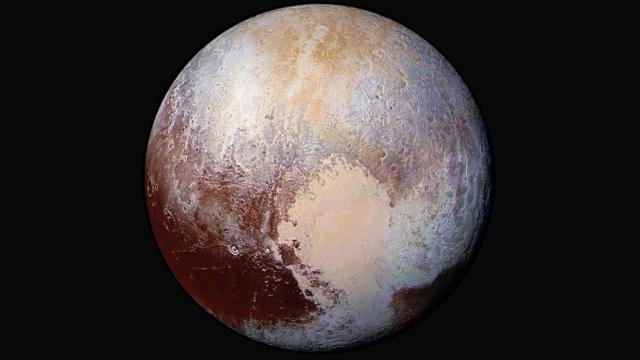In recent months, there’s been growing evidence that Pluto is hiding a liquid water ocean beneath its frozen surface. New models by researchers at Brown University support this hypothesis, and take it one mind-boggling step further: Pluto’s ocean may be more than 100km deep.
Image: NASA
That conclusion, which is published this week in Geophysical Research Letters, came about through a simple observation about Sputnik Planum, the enormous, heart-shaped crater that dominates the dwarf planet’s midsection. It turns out Sputnik Planum sits directly on the tidal axis linking Pluto to its largest moon, Charon.
As other researchers have noted, this curious position suggests that Sputnik Planum is a positive mass anomaly — an unusually heavy patch of Pluto’s crust. In fact, it’s thought that the enormous asteroid responsible for creating Sputnik Planum struck somewhere near the north pole, but that over time, Pluto’s heart became heavy and caused the entire planet to tip over.
Although the heavy-hearted hypothesis certainly satisfies our desire to anthropomorphise everything about Pluto, what could have caused Sputnik Planum to become so dense isn’t immediately obvious.
“An impact crater is basically a hole in the ground,” lead study author Brandon Johnson said in a statement. “You’re taking a bunch of material and blasting it out, so you expect it to have negative mass anomaly, but that’s not what we see with Sputnik Planum. That got people thinking about how you could get this positive mass anomaly.”
One possibility is that after the crater formed, the ground rebounded, pulling up water from Pluto’s deep interior. (Other studies have indicated there could be a very deep liquidy layer on Pluto, kept warm by a rocky core.) Because water is denser than ice, it could conceivably make Sputnik Planum heavier than its surroundings.
But how much water, exactly, is needed to make Pluto’s heart heavy enough? That’s the question Johnson and his colleagues sought to answer, by running a series of collisional models. It turns out, in order to reproduce a feature that look like present-day Sputnik Planum, you need a subsurface ocean more than 100km thick, with salinity levels of approximately 30 per cent. (Salinity increases the density of water, enhancing the positive mass anomaly.)
Thirty per cent salinity is about as salty as the Dead Sea — extreme, but not outside our realm of Earthly experience. A 100km-deep ocean, on the other hand, is nothing short of astonishing. The deepest parts of our ocean are a little over 10km. We’re talking about something 10 times deeper, on a world too small to be classified as a planet, at the frozen edge of our solar system.
Now, if that doesn’t make you want to grab some scuba gear, hop in a spaceship and blast off into the void, I don’t want to know you.
